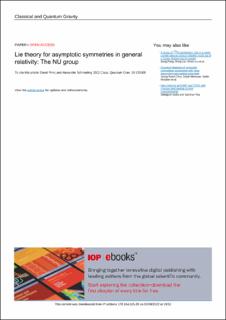| dc.contributor.author | Prinz, David Nicolas | |
| dc.contributor.author | Schmeding, Alexander | |
| dc.date.accessioned | 2022-11-10T11:47:34Z | |
| dc.date.available | 2022-11-10T11:47:34Z | |
| dc.date.created | 2022-06-10T17:12:23Z | |
| dc.date.issued | 2022 | |
| dc.identifier.citation | Prinz, D. N. & Schmeding, A. (2022). Lie theory for asymptotic symmetries in general relativity: The NU group. Classical and Quantum Gravity, 39(15). doi: | en_US |
| dc.identifier.issn | 1361-6382 | |
| dc.identifier.uri | https://hdl.handle.net/11250/3031145 | |
| dc.description.abstract | We study the Newman--Unti (NU) group from the viewpoint of infinite-dimensional geometry. The NU group is a topological group in a natural coarse topology, but it does not become a manifold and hence a Lie group in this topology. To obtain a manifold structure we consider a finer Whitney-type topology. This turns the unit component of the NU group into an infinite-dimensional Lie group. We then study the Lie theoretic properties of this group. Surprisingly, the group operations of the full NU group become discontinuous, whence the NU group does not support a Lie group structure. The NU group contains the Bondi--Metzner--Sachs (BMS) group as a subgroup, whose Lie group structure was constructed in a previous article. The lack of a Lie group structure on the NU group implies that, despite the known splitting of the NU Lie algebra into a direct sum of Lie ideals of the Lie algebras of the BMS group and conformal rescalings, the BMS group cannot be embedded as a Lie subgroup into the NU group. | en_US |
| dc.description.abstract | Lie theory for asymptotic symmetries in general relativity: The NU group | en_US |
| dc.language.iso | eng | en_US |
| dc.rights | Navngivelse 4.0 Internasjonal | * |
| dc.rights.uri | http://creativecommons.org/licenses/by/4.0/deed.no | * |
| dc.subject | Relativitetsteori | en_US |
| dc.subject | Theory of relativity | en_US |
| dc.subject | Lie grupper | en_US |
| dc.subject | Lie groups | en_US |
| dc.title | Lie theory for asymptotic symmetries in general relativity : The NU group | en_US |
| dc.title.alternative | Lie theory for asymptotic symmetries in general relativity: The NU group | en_US |
| dc.type | Peer reviewed | en_US |
| dc.type | Journal article | en_US |
| dc.description.version | publishedVersion | en_US |
| dc.rights.holder | © The Authors, 2022 | en_US |
| dc.subject.nsi | VDP::Matematikk og Naturvitenskap: 400::Matematikk: 410 | en_US |
| dc.subject.nsi | VDP::Matematikk og Naturvitenskap: 400::Fysikk: 430 | en_US |
| dc.subject.nsi | VDP::Matematikk og Naturvitenskap: 400::Matematikk: 410::Anvendt matematikk: 413 | en_US |
| dc.source.pagenumber | 31 | en_US |
| dc.source.volume | 39 | en_US |
| dc.source.journal | Classical and Quantum Gravity | en_US |
| dc.source.issue | 15 | en_US |
| dc.identifier.doi | 10.1088/1361-6382/ac776c | |
| dc.identifier.cristin | 2030930 | |

